+ Open data
Open data
- Basic information
Basic information
| Entry | Database: EMDB / ID: EMD-30458 | |||||||||
|---|---|---|---|---|---|---|---|---|---|---|
| Title | Cryo-EM structure of rNLRP1-rDPP9 complex | |||||||||
 Map data Map data | ||||||||||
 Sample Sample |
| |||||||||
 Keywords Keywords | IMMUNE SYSTEM | |||||||||
| Function / homology |  Function and homology information Function and homology informationnegative regulation of cellular defense response / NLRP1 inflammasome complex assembly / NLRP1 inflammasome complex / programmed necrotic cell death / self proteolysis / positive regulation of pyroptotic inflammatory response / NLRP3 inflammasome complex / dipeptidyl-peptidase IV / cysteine-type endopeptidase activator activity / dipeptidyl-peptidase activity ...negative regulation of cellular defense response / NLRP1 inflammasome complex assembly / NLRP1 inflammasome complex / programmed necrotic cell death / self proteolysis / positive regulation of pyroptotic inflammatory response / NLRP3 inflammasome complex / dipeptidyl-peptidase IV / cysteine-type endopeptidase activator activity / dipeptidyl-peptidase activity / Hydrolases; Acting on peptide bonds (peptidases) / negative regulation of programmed cell death / cellular response to UV-B / pattern recognition receptor activity / pyroptotic inflammatory response / response to muramyl dipeptide / cell leading edge / aminopeptidase activity / serine-type peptidase activity / signaling adaptor activity / antiviral innate immune response / intrinsic apoptotic signaling pathway / activation of innate immune response / positive regulation of interleukin-1 beta production / molecular condensate scaffold activity / protein homooligomerization / positive regulation of inflammatory response / peptidase activity / double-stranded RNA binding / regulation of inflammatory response / double-stranded DNA binding / neuron apoptotic process / scaffold protein binding / regulation of apoptotic process / defense response to virus / microtubule / defense response to bacterium / inflammatory response / protein domain specific binding / neuronal cell body / enzyme binding / signal transduction / ATP hydrolysis activity / protein-containing complex / proteolysis / ATP binding / identical protein binding / nucleus / cytosol Similarity search - Function | |||||||||
| Biological species |  | |||||||||
| Method | single particle reconstruction / cryo EM / Resolution: 3.18 Å | |||||||||
 Authors Authors | Huang MH / Zhang XX | |||||||||
| Funding support |  China, 1 items China, 1 items
| |||||||||
 Citation Citation |  Journal: Nature / Year: 2021 Journal: Nature / Year: 2021Title: Structural and biochemical mechanisms of NLRP1 inhibition by DPP9. Authors: Menghang Huang / Xiaoxiao Zhang / Gee Ann Toh / Qin Gong / Jia Wang / Zhifu Han / Bin Wu / Franklin Zhong / Jijie Chai /    Abstract: Nucleotide-binding domain, leucine-rich repeat receptors (NLRs) mediate innate immunity by forming inflammasomes. Activation of the NLR protein NLRP1 requires autocleavage within its function-to-find ...Nucleotide-binding domain, leucine-rich repeat receptors (NLRs) mediate innate immunity by forming inflammasomes. Activation of the NLR protein NLRP1 requires autocleavage within its function-to-find domain (FIIND). In resting cells, the dipeptidyl peptidases DPP8 and DPP9 interact with the FIIND of NLRP1 and suppress spontaneous NLRP1 activation; however, the mechanisms through which this occurs remain unknown. Here we present structural and biochemical evidence that full-length rat NLRP1 (rNLRP1) and rat DPP9 (rDPP9) form a 2:1 complex that contains an autoinhibited rNLRP1 molecule and an active UPA-CARD fragment of rNLRP1. The ZU5 domain is required not only for autoinhibition of rNLRP1 but also for assembly of the 2:1 complex. Formation of the complex prevents UPA-mediated higher-order oligomerization of UPA-CARD fragments and strengthens ZU5-mediated NLRP1 autoinhibition. Structure-guided biochemical and functional assays show that both NLRP1 binding and enzymatic activity are required for DPP9 to suppress NLRP1 in human cells. Together, our data reveal the mechanism of DPP9-mediated inhibition of NLRP1 and shed light on the activation of the NLRP1 inflammasome. | |||||||||
| History |
|
- Structure visualization
Structure visualization
| Movie |
 Movie viewer Movie viewer |
|---|---|
| Structure viewer | EM map:  SurfView SurfView Molmil Molmil Jmol/JSmol Jmol/JSmol |
| Supplemental images |
- Downloads & links
Downloads & links
-EMDB archive
| Map data |  emd_30458.map.gz emd_30458.map.gz | 5 MB |  EMDB map data format EMDB map data format | |
|---|---|---|---|---|
| Header (meta data) |  emd-30458-v30.xml emd-30458-v30.xml emd-30458.xml emd-30458.xml | 15.2 KB 15.2 KB | Display Display |  EMDB header EMDB header |
| Images |  emd_30458.png emd_30458.png | 54.2 KB | ||
| Filedesc metadata |  emd-30458.cif.gz emd-30458.cif.gz | 6.8 KB | ||
| Archive directory |  http://ftp.pdbj.org/pub/emdb/structures/EMD-30458 http://ftp.pdbj.org/pub/emdb/structures/EMD-30458 ftp://ftp.pdbj.org/pub/emdb/structures/EMD-30458 ftp://ftp.pdbj.org/pub/emdb/structures/EMD-30458 | HTTPS FTP |
-Validation report
| Summary document |  emd_30458_validation.pdf.gz emd_30458_validation.pdf.gz | 375.5 KB | Display |  EMDB validaton report EMDB validaton report |
|---|---|---|---|---|
| Full document |  emd_30458_full_validation.pdf.gz emd_30458_full_validation.pdf.gz | 375 KB | Display | |
| Data in XML |  emd_30458_validation.xml.gz emd_30458_validation.xml.gz | 6 KB | Display | |
| Data in CIF |  emd_30458_validation.cif.gz emd_30458_validation.cif.gz | 6.9 KB | Display | |
| Arichive directory |  https://ftp.pdbj.org/pub/emdb/validation_reports/EMD-30458 https://ftp.pdbj.org/pub/emdb/validation_reports/EMD-30458 ftp://ftp.pdbj.org/pub/emdb/validation_reports/EMD-30458 ftp://ftp.pdbj.org/pub/emdb/validation_reports/EMD-30458 | HTTPS FTP |
-Related structure data
| Related structure data |  7crwMC  7crvC M: atomic model generated by this map C: citing same article ( |
|---|---|
| Similar structure data |
- Links
Links
| EMDB pages |  EMDB (EBI/PDBe) / EMDB (EBI/PDBe) /  EMDataResource EMDataResource |
|---|---|
| Related items in Molecule of the Month |
- Map
Map
| File |  Download / File: emd_30458.map.gz / Format: CCP4 / Size: 52.7 MB / Type: IMAGE STORED AS FLOATING POINT NUMBER (4 BYTES) Download / File: emd_30458.map.gz / Format: CCP4 / Size: 52.7 MB / Type: IMAGE STORED AS FLOATING POINT NUMBER (4 BYTES) | ||||||||||||||||||||||||||||||||||||||||||||||||||||||||||||||||||||
|---|---|---|---|---|---|---|---|---|---|---|---|---|---|---|---|---|---|---|---|---|---|---|---|---|---|---|---|---|---|---|---|---|---|---|---|---|---|---|---|---|---|---|---|---|---|---|---|---|---|---|---|---|---|---|---|---|---|---|---|---|---|---|---|---|---|---|---|---|---|
| Projections & slices | Image control
Images are generated by Spider. | ||||||||||||||||||||||||||||||||||||||||||||||||||||||||||||||||||||
| Voxel size | X=Y=Z: 1.061 Å | ||||||||||||||||||||||||||||||||||||||||||||||||||||||||||||||||||||
| Density |
| ||||||||||||||||||||||||||||||||||||||||||||||||||||||||||||||||||||
| Symmetry | Space group: 1 | ||||||||||||||||||||||||||||||||||||||||||||||||||||||||||||||||||||
| Details | EMDB XML:
CCP4 map header:
| ||||||||||||||||||||||||||||||||||||||||||||||||||||||||||||||||||||
-Supplemental data
- Sample components
Sample components
-Entire : Complex of Nlrp1-FIIND with DPP9 dimer
| Entire | Name: Complex of Nlrp1-FIIND with DPP9 dimer |
|---|---|
| Components |
|
-Supramolecule #1: Complex of Nlrp1-FIIND with DPP9 dimer
| Supramolecule | Name: Complex of Nlrp1-FIIND with DPP9 dimer / type: complex / ID: 1 / Parent: 0 / Macromolecule list: all |
|---|---|
| Source (natural) | Organism:  |
-Macromolecule #1: Dipeptidyl peptidase 9
| Macromolecule | Name: Dipeptidyl peptidase 9 / type: protein_or_peptide / ID: 1 / Number of copies: 2 / Enantiomer: LEVO |
|---|---|
| Source (natural) | Organism:  |
| Molecular weight | Theoretical: 98.203273 KDa |
| Recombinant expression | Organism:  |
| Sequence | String: MSGGVSPVEQ VAAGDMDDTA ARFCVQKHSW DGLRNIIHGS RKSSGLIVSK APHDFQFVQK PDESGPHSHR LYYLGMPYGS RENSLLYSE IPKKVRKEAL LLLSWKQMLD HFQATPHHGV YSREEELLRE RKRLGVFGIT SYDFHSESGL FLFQASNSLF H CRDGGKNG ...String: MSGGVSPVEQ VAAGDMDDTA ARFCVQKHSW DGLRNIIHGS RKSSGLIVSK APHDFQFVQK PDESGPHSHR LYYLGMPYGS RENSLLYSE IPKKVRKEAL LLLSWKQMLD HFQATPHHGV YSREEELLRE RKRLGVFGIT SYDFHSESGL FLFQASNSLF H CRDGGKNG FMVSPMKPLE IKTQCSGPRM DPKICPADPA FFSFINNNDL WVANIETGEE RRLTFCHQGS ASVLDNPKSA GV ATFVIQE EFDRFTGCWW CPTASWEGSG GLKTLRILYE EVDESEVEVI HVPSPALEER KTDSYRYPRT GSKNPKIALK LAE LQTDHQ GKIVSSCEKE LVQPFSSLFP KVEYIARAGW TRDGRYAWAM FLDRPQQRLQ LVLLPPALFI PTLESEAQWQ EAAR AIPKN VQPFIIYEEV TNVWINVHDI FHPFPQAEGQ QDFCFLRANE CKTGFCHLYR VTVDLKTNDY DWTEPLSPAE DEFKC PIKE EVALTSGEWE VLSRHGSKIW VNEQTKLVYF QGTKDTPLEH HLYVVSYESA GEIVRLTTPG FSHSCSMSQN FDMFVS HYS SVSTPPCVHV YKLSGPDDDP LHKQPRFWAS MMEAASCPPD YVPPEIFHFH TRADVQLYGM IYKPHTLQPG RKHPTVL FV YGGPQVQLVN NSFKGIKYLR LNTLASLGYA VVVIDGRGSC QRGLHFEGAL KNQMGQVEIE DQVEGLQYVA EKYGFIDL S RVAIHGWSYG GFLSLMGLIH KPQVFKVAIA GAPVTVWMAY DTGYTERYMD VPENNQQGYE AGSVALHVEK LPNEPNRLL ILHGFLDENV HFFHTNFLVS QLIRAGKPYQ LQIYPNERHS IRCRESGEHY EVTLLHFLQE HL UniProtKB: dipeptidyl-peptidase IV |
-Macromolecule #2: NLR family protein 1
| Macromolecule | Name: NLR family protein 1 / type: protein_or_peptide / ID: 2 / Number of copies: 2 / Enantiomer: LEVO |
|---|---|
| Source (natural) | Organism:  |
| Molecular weight | Theoretical: 138.577859 KDa |
| Recombinant expression | Organism:  |
| Sequence | String: MEESQSKQES NTRVAQHGSQ QDVDPTFQTK RALEKERSKP RPRPLPRVQL QSLPGWSSTS KDVPLSQLIR EMDHESRRCI HRSKKKLDR SEHISQGTIP EIYEKRKETI SHTQSMEQKY LFQNFTKLLL LQKCCPGGSE KLVRESWHPC VPEEGGHMIE I QDLFDPNL ...String: MEESQSKQES NTRVAQHGSQ QDVDPTFQTK RALEKERSKP RPRPLPRVQL QSLPGWSSTS KDVPLSQLIR EMDHESRRCI HRSKKKLDR SEHISQGTIP EIYEKRKETI SHTQSMEQKY LFQNFTKLLL LQKCCPGGSE KLVRESWHPC VPEEGGHMIE I QDLFDPNL DTEKKPQLVI IEGAAGIGKS TLARQVKRAW DEGQLYRDRF QHVFFFSCRE LAQCKQLSLA ELIAQGQEVP TA PTRQILS RPEKLLFILD GIDEPAWVLE DQNPELCVHW SQAQPVHTLL GSLLGKSILP EASLMLTART TALQKLVPSL GQP HRVEVL GFSEFERKDY FYKYFAKERN TIIDFNLIGS IPVLLTLCEV PWVCWLLCTC LEKQMQQGEV LSLTSQTTTA LCLK YLSLT IPGQHLSTQL RTLCSLAAEG ICQRRTLFSK SDLCKQGLAE DAIATFLKIG VLQRQPSSLS YSFAHLCLQE FFAAM SYIL EDSEEAHGDM GNDRTVETLV ERYGRQNLFE APTVRFLLGL LNTREMREME NIFACKFPWE TKLKLLQSII GEPFCQ PCH LGLFHCLYEN QEEELLTETM LCFPLTASGP NHMEATVFQT NVKRLVIQTD MELMVVTFCI TFSHVRSLRL KGKGQQE YK LTAPAMVLYR WTPISEASWK VLFSNLKCTR NLEELDLSGN PLSYSAVRSL CTALRQPGCR LKTLWLVDCG LTSRCCSF L ASMLSAHSRL AELDLRLNDL GDNGVRQLCE GLRNPACNLS ILRLDQASLS EQVITELRAL ETKNPKLFIS STWMSHMTM PTENTDGEES LTSSKQQQQQ SGDKHMEPLG TDDDFWGPSG PVSTEVVDRE RNLYRVRLPM AGSYHCPSTG LHFVVTRAVT IEIGFCAWS QFLHETPLQH SHMVAGPLFD IKAEHGAVTA VCLPHFVSLQ EGKVDSSLFH VAHFQDHGMV LETPARVEPH F AVLENPSF SPMGVLLRMI PAVGHFIPIT SITLIYYRLY LEDITFHLYL VPNDCTIRKA IDEEELKFQF VRINKPPPVD AL YVGSRYI VSSSKEVEIL PKELELCYRS PRESQLFSEI YVGNIGSGIN LQLTDKKYMN LIWEALLKPG DLRPALPRMA SAP KDAPAL LHFVDQHREQ LVARVTSVDP LLDKLHGLVL SEEDYETVRA EATNQDKMRK LFRGSRSWSW DCKDHFYQAL KETH PHLIM DLLEKSGGVS VRL UniProtKB: NACHT, LRR and PYD domains-containing protein 1 allele 2 |
-Experimental details
-Structure determination
| Method | cryo EM |
|---|---|
 Processing Processing | single particle reconstruction |
| Aggregation state | particle |
- Sample preparation
Sample preparation
| Buffer | pH: 8 |
|---|---|
| Vitrification | Cryogen name: ETHANE |
- Electron microscopy
Electron microscopy
| Microscope | FEI TITAN KRIOS |
|---|---|
| Image recording | Film or detector model: GATAN K2 SUMMIT (4k x 4k) / Average electron dose: 50.0 e/Å2 |
| Electron beam | Acceleration voltage: 300 kV / Electron source:  FIELD EMISSION GUN FIELD EMISSION GUN |
| Electron optics | Illumination mode: FLOOD BEAM / Imaging mode: BRIGHT FIELD |
| Experimental equipment |  Model: Titan Krios / Image courtesy: FEI Company |
 Movie
Movie Controller
Controller





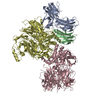
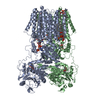

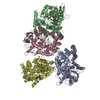

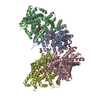

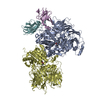












 Z (Sec.)
Z (Sec.) Y (Row.)
Y (Row.) X (Col.)
X (Col.)





















